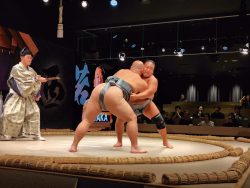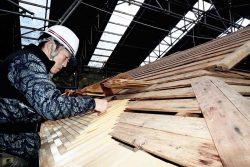
Children watch demekin goldfish swim in an aquarium in front of a clock store along the Koriyama Yanagimachi shopping street in Yamatokoriyama, Nara Prefecture.
18:35 JST, January 22, 2021
YAMATO-KORIYAMA, Nara — Goldfish swim along the shopping street in Yamatokoriyama, Nara Prefecture, as if the main drag is one giant aquarium.
The 600-meter-long passage is lined with long-established kimono shops, public baths, restaurants and other stores. Inside the 28 shops are 30 water tanks of various shapes and sizes, in which a total of about 250 goldfish of 30 different species swim around to the delight the shoppers and tourists.
Yamato-Koriyama is one of the top goldfish producers in Japan, and the city created the “Goldfish Street” event that began Nov. 22 along Koriyama Yanagimachi shopping street near Kintetsu-Koriyama Station in a bid to attract more tourists to the area.
Lazily swimming around are comet goldfish with their featherlike tails, ryukin, which have plump bodies and long, elegant tails, as well as demekin or telescope goldfish, which are distinguished by their protruding eyes.
Yamato-Koriyama is famous throughout the country for its goldfish, and the shopping districts’ proprietors noted that visitors to the city had often asked them where they could see the dazzling fish.
The area once had a goldfish aquarium made of a repurposed phone booth, which was popular with tourists, but the novelty item was removed in April 2018, leaving few places where tourists could see the city’s iconic commodity.
So the owners hit on the idea to expand their brand and use goldfish as a catalyst to revitalize the shopping district, which has seen less foot traffic every year.
“Goldfish are our local treasure,” said Mitsunori Kitatani, the head of the shopping district cooperative. “We want tourists and children to learn more about them.”
The cooperative plans to hold more events in the future, such as a goldfish photo contest, and is considering hosting a stamp rally to entice people to visit every shop.
“I’ve always been around goldfish, but I didn’t know there were so many different kinds,” said a 63-year-old visitor to the shopping street. “I hope many people come to see these goldfish and revitalize the district in the process.”
■ More viewing opportunities
A facility in front of JR Koriyama Station that provides tourist information and city government information also emphasizes promoting goldfish as the city’s symbol.
The Yamato-Koriyama city tourism association has decorated the entrance of the Citizens Exchange Center building with 14 goldfish objects of various sizes, which are illuminated at night. And a tank has been installed near the objects, where goldfish are swimming.
In the center, collections including goldfish-related arts and crafts are in display.
■ Scooping for gold

Participants try to catch goldfish in the 2019 National Championship of Goldfish Scooping.
Yamato-Koriyama has held the National Championship of Goldfish Scooping every year since 1995, but the 2020 event was canceled for the first time because of the novel coronavirus pandemic.
Goldfish scooping is a game in which players use a “poi” scoop, which has a net made of washi Japanese paper, to catch as many swimming goldfish as possible.
The number of participants in the competition has been increasing, and the summer tradition had more than 1,500 contestants in recent years.
The 2019 event was dubbed the first “world championship” and attracted about 20,000 visitors from home and abroad.
■ Dyeing museum another viewing spot

Exterior of the Hakomotokan Konya museum in Yamatokoriyama, Nara Prefecture.
YAMATO-KORIYAMA, Nara — An indigo dyeing museum in Yamato-Koriyama is becoming increasingly popular as a place where visitors can enjoy the elegance of goldfish.
The townhouse of the Okuno family, which had been involved in indigo dyeing since the Edo period (1603-1867), was restored, and the city government opened the structure as the Hakomotokan Konya museum in 2000 in hopes of it becoming a tourist attraction.
However, due to the spread of the novel coronavirus, the museum was temporarily closed and the indigo dyeing classes were suspended, which caused visitor number to plunge.
In July last year, the museum started charging no admission fee — usually ¥300 for adults and ¥100 for elementary and junior high school students. The number began to increase and reached 1,082 in August, nearly four times compared with 2019.
The museum has a self-service drink room where visitors can purchase coffee for ¥100 per cup, and fish-filled aquariums — with species such as the comet, shubunkin and ping-pong pearl that when it matures has a belly resembling a Ping-Pong ball — decorate the entrance.
Related Tags
"Features" POPULAR ARTICLE
-

Students Recreate 19th-Century Bento Boxes Made for Ino Tadataka’s Survey Team in Hot Spring Town on Nakasendo Road
-

Santa Claus Delivers Christmas Presents to Penguins at Aquarium in Japan’s Nagasaki Prefecture
-

Sumo Restaurant in Tokyo Teaches Foreign Visitors About the Ancient Sport, with Bouts Between Retired Rikishi
-

Autonomous Passenger Ship Connects Mainland with Remote Island in Seto Inland Sea; World’s 1st Commercially Operated Autonomous Vessel
-

Osaka’s Sumiyoshi Taisha Shrine Bustles with New Year’s Visitors
JN ACCESS RANKING
-

As Chinese Tourists Shun Japan, Hotels and Stores Suffer
-

Osaka-Kansai Expo’s Economic Impact Estimated at ¥3.6 Trillion, Takes Actual Visitor Numbers into Account
-

Japan Govt Adopts Measures to Curb Mega Solar Power Plant Projects Amid Environmental Concerns
-

BOJ Gov. Ueda: Highly Likely Mechanism for Rising Wages, Prices Will Be Maintained
-

Economic Security Panels Debate Supply Chains, Rare Earths; Participants Emphasize Importance of Cooperation Among Allies



























